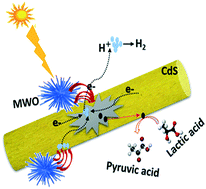当前位置:
X-MOL 学术
›
Catal. Sci. Technol.
›
论文详情
Our official English website, www.x-mol.net, welcomes your
feedback! (Note: you will need to create a separate account there.)
Multidirectional-charge-transfer urchin-type Mo-doped W18O49 nanostructures on CdS nanorods for enhanced photocatalytic hydrogen evolution†
Catalysis Science & Technology ( IF 4.4 ) Pub Date : 2018-02-19 00:00:00 , DOI: 10.1039/c7cy02162c P. Bhavani 1, 2, 3, 4 , D. Praveen Kumar 1, 2, 3, 4 , Seonghyun Jeong 4, 5, 6, 7 , Eun Hwa Kim 1, 2, 3, 4 , Hanbit Park 1, 2, 3, 4 , Sangyeob Hong 1, 2, 3, 4 , Madhusudana Gopannagari 1, 2, 3, 4 , D. Amaranatha Reddy 1, 2, 3, 4 , Jae Kyu Song 4, 5, 6, 7 , Tae Kyu Kim 1, 2, 3, 4
Catalysis Science & Technology ( IF 4.4 ) Pub Date : 2018-02-19 00:00:00 , DOI: 10.1039/c7cy02162c P. Bhavani 1, 2, 3, 4 , D. Praveen Kumar 1, 2, 3, 4 , Seonghyun Jeong 4, 5, 6, 7 , Eun Hwa Kim 1, 2, 3, 4 , Hanbit Park 1, 2, 3, 4 , Sangyeob Hong 1, 2, 3, 4 , Madhusudana Gopannagari 1, 2, 3, 4 , D. Amaranatha Reddy 1, 2, 3, 4 , Jae Kyu Song 4, 5, 6, 7 , Tae Kyu Kim 1, 2, 3, 4
Affiliation

|
Transition metal oxides (TMOs) have attracted attention because they provide eco-friendly ways of collecting solar energy and are more stable than sulfides or phosphides for photoirradiation over long periods without photocorrosion. Among TMOs, tungsten oxides have attracted considerable attention owing to their excellent electron transport properties and good resilience to photocorrosion in aqueous media. However, pristine WO3 exhibits low photocatalytic activity because of the rapid recombination of its photogenerated charge-carriers and its narrow photo-absorption range. Consequently, the monoclinic oxygen-deficient (WO3−δ) material W18O49 (≅WO2.73) has attracted greater interest than typical tungsten oxides due to its high chemical stability and large number of oxygen vacancies (OVs). In particular, the water splitting efficiency of W18O49 is enhanced by doping with Mo, which modifies the intrinsic chemical properties of W18O49 without disturbing the crystal structure while producing more active sites. Furthermore, by tuning the morphology of Mo-W18O49 (MWO), the photocatalytic activity of MWO-embedded CdS was greatly enhanced by the very large surface area and supplementary active sites. To that end, we developed an urchin-type MWO cocatalyst integrated into CdS nanorods (NRs) by simple methods. The catalyst exhibits an enhanced production rate of H2 (40.225 mmol h−1 g−1) under simulated solar light irradiation, which is 20 times higher than that of pristine CdS NRs. The urchin-type morphology significantly shortens charge-carrier transport distances. The oxygen deficiency and Mo dopant in the W18O49 system also improve the number of active sites, which promotes the efficient utilization of light, excellent electron-transport properties, and good resilience to photocorrosion. These properties are especially beneficial for the effective excitation and separation of charge-carriers that are directed to the reduction of protons to H2. Moreover, to the best of our knowledge, this material exhibits the best performance among reported tungsten-based oxides as a cocatalyst on CdS composites.
中文翻译:

CdS纳米棒上的 多方向电荷转移顽固型Mo掺杂的W 18 O 49纳米结构,可增强光催化氢的产生†
过渡金属氧化物(TMO)吸引了人们的注意,因为它们提供了生态友好的太阳能收集方式,并且比硫化物或磷化物更稳定,可长期长时间进行光辐照而不会发生光腐蚀。在TMO中,氧化钨由于其出色的电子传输性能和在水性介质中对光腐蚀的良好回弹性而备受关注。然而,原始WO 3由于其光生电荷载体的快速重组和窄的光吸收范围而表现出低的光催化活性。因此,单斜晶系氧不足型的(WO 3- δ)材料W 18 ö 49(≅WO 2.73由于其高的化学稳定性和大量的氧空位(OVs),因此比典型的氧化钨吸引了更多的兴趣。特别地,通过掺杂Mo来提高W 18 O 49的水分解效率,这改变了W 18 O 49的内在化学性质而不会干扰晶体结构,同时产生了更多的活性位点。此外,通过调整Mo-W 18 O 49的形态(MWO),非常大的表面积和补充的活性位点极大地增强了嵌入MWO的CdS的光催化活性。为此,我们开发了一种通过简单方法整合到CdS纳米棒(NRs)中的海胆型MWO助催化剂。在模拟的太阳光照射下,该催化剂显示出更高的H 2生产率(40.225 mmol h -1 g -1),是原始CdS NRs的20倍。海胆型形态显着缩短了电荷载流子的传输距离。W 18 O 49中的氧缺乏和Mo掺杂该系统还改善了活性位点的数量,从而促进了光的有效利用,出色的电子传输性能以及良好的抗光腐蚀能力。这些性质对于有效激发和分离将质子还原为H 2的载流子特别有益。而且,据我们所知,这种材料在报道的基于钨的氧化物中作为CdS复合材料的助催化剂表现出最好的性能。
更新日期:2018-02-19
中文翻译:

CdS纳米棒上的 多方向电荷转移顽固型Mo掺杂的W 18 O 49纳米结构,可增强光催化氢的产生†
过渡金属氧化物(TMO)吸引了人们的注意,因为它们提供了生态友好的太阳能收集方式,并且比硫化物或磷化物更稳定,可长期长时间进行光辐照而不会发生光腐蚀。在TMO中,氧化钨由于其出色的电子传输性能和在水性介质中对光腐蚀的良好回弹性而备受关注。然而,原始WO 3由于其光生电荷载体的快速重组和窄的光吸收范围而表现出低的光催化活性。因此,单斜晶系氧不足型的(WO 3- δ)材料W 18 ö 49(≅WO 2.73由于其高的化学稳定性和大量的氧空位(OVs),因此比典型的氧化钨吸引了更多的兴趣。特别地,通过掺杂Mo来提高W 18 O 49的水分解效率,这改变了W 18 O 49的内在化学性质而不会干扰晶体结构,同时产生了更多的活性位点。此外,通过调整Mo-W 18 O 49的形态(MWO),非常大的表面积和补充的活性位点极大地增强了嵌入MWO的CdS的光催化活性。为此,我们开发了一种通过简单方法整合到CdS纳米棒(NRs)中的海胆型MWO助催化剂。在模拟的太阳光照射下,该催化剂显示出更高的H 2生产率(40.225 mmol h -1 g -1),是原始CdS NRs的20倍。海胆型形态显着缩短了电荷载流子的传输距离。W 18 O 49中的氧缺乏和Mo掺杂该系统还改善了活性位点的数量,从而促进了光的有效利用,出色的电子传输性能以及良好的抗光腐蚀能力。这些性质对于有效激发和分离将质子还原为H 2的载流子特别有益。而且,据我们所知,这种材料在报道的基于钨的氧化物中作为CdS复合材料的助催化剂表现出最好的性能。











































 京公网安备 11010802027423号
京公网安备 11010802027423号